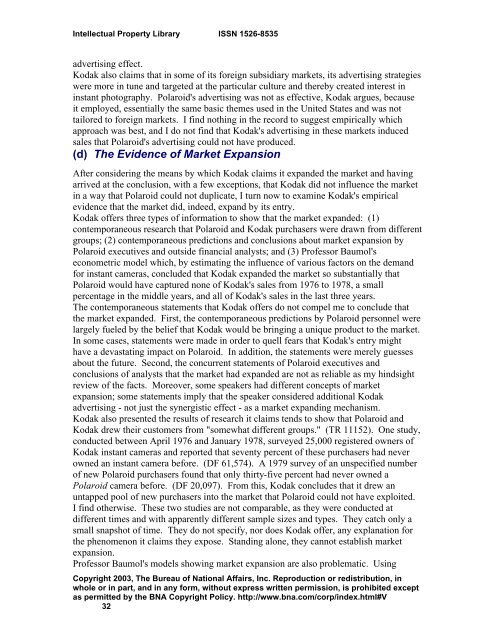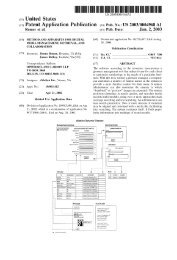Polaroid Corp. v. Eastman Kodak Co. - Oppedahl Patent Law Firm LLC
Polaroid Corp. v. Eastman Kodak Co. - Oppedahl Patent Law Firm LLC
Polaroid Corp. v. Eastman Kodak Co. - Oppedahl Patent Law Firm LLC
Create successful ePaper yourself
Turn your PDF publications into a flip-book with our unique Google optimized e-Paper software.
Intellectual Property Library ISSN 1526-8535<br />
advertising effect.<br />
<strong>Kodak</strong> also claims that in some of its foreign subsidiary markets, its advertising strategies<br />
were more in tune and targeted at the particular culture and thereby created interest in<br />
instant photography. <strong>Polaroid</strong>'s advertising was not as effective, <strong>Kodak</strong> argues, because<br />
it employed, essentially the same basic themes used in the United States and was not<br />
tailored to foreign markets. I find nothing in the record to suggest empirically which<br />
approach was best, and I do not find that <strong>Kodak</strong>'s advertising in these markets induced<br />
sales that <strong>Polaroid</strong>'s advertising could not have produced.<br />
(d) The Evidence of Market Expansion<br />
After considering the means by which <strong>Kodak</strong> claims it expanded the market and having<br />
arrived at the conclusion, with a few exceptions, that <strong>Kodak</strong> did not influence the market<br />
in a way that <strong>Polaroid</strong> could not duplicate, I turn now to examine <strong>Kodak</strong>'s empirical<br />
evidence that the market did, indeed, expand by its entry.<br />
<strong>Kodak</strong> offers three types of information to show that the market expanded: (1)<br />
contemporaneous research that <strong>Polaroid</strong> and <strong>Kodak</strong> purchasers were drawn from different<br />
groups; (2) contemporaneous predictions and conclusions about market expansion by<br />
<strong>Polaroid</strong> executives and outside financial analysts; and (3) Professor Baumol's<br />
econometric model which, by estimating the influence of various factors on the demand<br />
for instant cameras, concluded that <strong>Kodak</strong> expanded the market so substantially that<br />
<strong>Polaroid</strong> would have captured none of <strong>Kodak</strong>'s sales from 1976 to 1978, a small<br />
percentage in the middle years, and all of <strong>Kodak</strong>'s sales in the last three years.<br />
The contemporaneous statements that <strong>Kodak</strong> offers do not compel me to conclude that<br />
the market expanded. First, the contemporaneous predictions by <strong>Polaroid</strong> personnel were<br />
largely fueled by the belief that <strong>Kodak</strong> would be bringing a unique product to the market.<br />
In some cases, statements were made in order to quell fears that <strong>Kodak</strong>'s entry might<br />
have a devastating impact on <strong>Polaroid</strong>. In addition, the statements were merely guesses<br />
about the future. Second, the concurrent statements of <strong>Polaroid</strong> executives and<br />
conclusions of analysts that the market had expanded are not as reliable as my hindsight<br />
review of the facts. Moreover, some speakers had different concepts of market<br />
expansion; some statements imply that the speaker considered additional <strong>Kodak</strong><br />
advertising - not just the synergistic effect - as a market expanding mechanism.<br />
<strong>Kodak</strong> also presented the results of research it claims tends to show that <strong>Polaroid</strong> and<br />
<strong>Kodak</strong> drew their customers from "somewhat different groups." (TR 11152). One study,<br />
conducted between April 1976 and January 1978, surveyed 25,000 registered owners of<br />
<strong>Kodak</strong> instant cameras and reported that seventy percent of these purchasers had never<br />
owned an instant camera before. (DF 61,574). A 1979 survey of an unspecified number<br />
of new <strong>Polaroid</strong> purchasers found that only thirty-five percent had never owned a<br />
<strong>Polaroid</strong> camera before. (DF 20,097). From this, <strong>Kodak</strong> concludes that it drew an<br />
untapped pool of new purchasers into the market that <strong>Polaroid</strong> could not have exploited.<br />
I find otherwise. These two studies are not comparable, as they were conducted at<br />
different times and with apparently different sample sizes and types. They catch only a<br />
small snapshot of time. They do not specify, nor does <strong>Kodak</strong> offer, any explanation for<br />
the phenomenon it claims they expose. Standing alone, they cannot establish market<br />
expansion.<br />
Professor Baumol's models showing market expansion are also problematic. Using<br />
<strong>Co</strong>pyright 2003, The Bureau of National Affairs, Inc. Reproduction or redistribution, in<br />
whole or in part, and in any form, without express written permission, is prohibited except<br />
as permitted by the BNA <strong>Co</strong>pyright Policy. http://www.bna.com/corp/index.html#V<br />
32





